by Lucile Chastre //
Musées à Séoul, les fleurons de l’art contemporain
Quels sont les musées d’art contemporain à voir en priorité à Séoul ? Le visiteur n’aura que l’embarras du choix, tant l’offre est profuse, bouillonnante. Les expositions temporaires s’emballent avec la fougue de la création coréenne. Les collections permanentes se renouvellent sur un rythme à peine moins rapide. Et dans l’année qui vient, on annonce l’ouverture d’au moins trois nouveaux musées : Photography Seoul Museum of Art, Seo-Seoul Museum of Art et le Centre Pompidou Hanwha Seoul.
Dans un cadre architectural souvent spectaculaire, les musées d’art contemporain privés et publics de Séoul mettent en lumière la création nationale comme internationale. Bien des surprises, voire des révélations attendent le visiteur. Laissez-vous guider par ACA project et notre sélection des musées d’art contemporain de Séoul à ne pas louper !
Museums in Seoul, Contemporary Art Jewels
Seoul’s contemporary art scene is rich and constantly evolving. Spectacular events and exhibitions bursting with creative energy seem to continuously sprout around Korea’s big city. Three new establishments are set to open next year: Photography Seoul Museum of Art, Seo-Seoul Museum of Art and the Centre Pompidou Hanwha Seoul.
In spectacular architectural settings, private and public museums showcase the most important and latest National and International creations. Interestingly, they regularly rotate not only their temporary exhibitions, but also their permanent collections. So, if you were to choose to visit only one contemporary art venue in Seoul, which one would it be? Let ACA project be your guide and get ready for shocks, surprises, and even revelations! Here is a selection of some of Seoul’s most stunning contemporary art museums.

Exterior view of Arario Museum in Space. Photograph by Lucile Chastre © Lucile Chastre 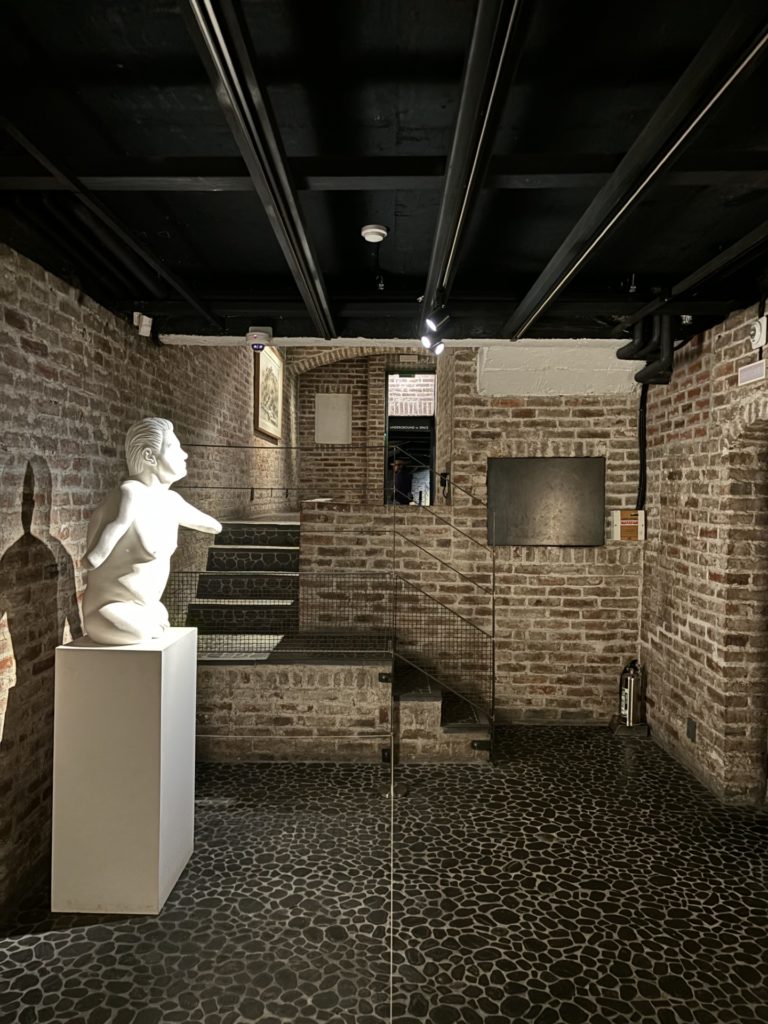
Inner view of Arario Museum in Space with Peter Hull (2002) by Marc Quinn. Photograph by Lucile Chastre © Lucile Chastre
ARARIO MUSEUM in Space
ARARIO MUSEUM a ouvert à Séoul en 2014, dans un complexe architectural qui est une œuvre à part entière, dessinée par trois maîtres de l’agence coréenne Space. L’institution séoulite, à laquelle s’ajoute ARARIO MUSEUM JEJU sur l’île du même nom, donne à voir l’étendue de la collection contemporaine rassemblée par l’artiste et homme d’affaires Ci Kim. Peintures, photographies, sculptures, vidéos et installations offrent un panorama de l’art international des 50 dernières années. Aux côtés de Keith Haring, Tracey Emin, Andy Warhol, Cindy Sherman et Sophie Calle, les artistes asiatiques sont à l’honneur, parmi lesquels Nam June Paik, Osang Gwon, Subodh Gupta, Nalini Malani, Kohei Nawa, Tatsuo Miyajima et Li Qing.
Exposition temporaire à voir en septembre 2024 à ARARIO MUSEUM in Space :
ARARIO Collection Highlights | Eclipse (jusqu’au 10 novembre) : l’exposition présente les œuvres de cinq artistes internationaux, inspirés par le spectacle des éclipses : Laurent Grasso, Bharti Kher, Rosa Loy, Neo Rauch et Kiki Smith. Nourries par des expériences personnelles, des mythes, des contes et des connaissances scientifiques, les créations emmènent le spectateur dans univers où imaginaire et réalité coexistent.
ARARIO MUSEUM in Space opened in Seoul in 2014. It is hosted in a magistral architectural complex designed by Korean agency Space. The Seoul institution (and its extension on the Southern Jeju island) gives a glimpse on the broad contemporary art collection assembled by artist and businessman Ci Kim. Paintings, photos, sculptures, videos and installations offer a panorama of international art of the last 50 years. Alongside Keith Haring, Tracey Emin, Andy Warhol, Cindy Sherman and Sophie Calle, Asian artists take center stage, including Nam June Paik, Osang Gwon, Subodh Gupta, Nalini Malani, Kohei Nawa, Tatsuo Miyajima and Li Qing.
A temporary exhibition at ARARIO MUSEUM in Space in September 2024:
« ARARIO Collection Highlights | Eclipse » (~ 2024.11.10): the exhibition features work by five international artists inspired by the spectacle of eclipses: Laurent Grasso, Bharti Kher, Rosa Loy, Neo Rauch and Kiki Smith. Inspired by personal experience, myths, tales and scientific knowledge, their creations take the viewer into a world where imagination and reality coexist.
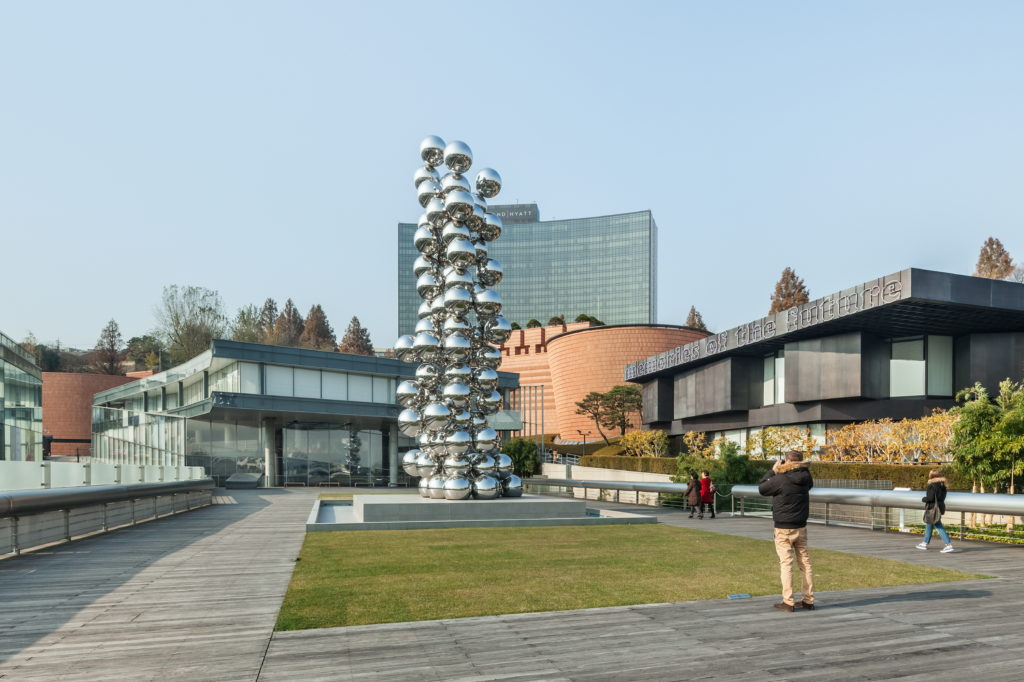
Exterior of Leeum Museum of Art. Photograph by Kyung Sub Shin © mhan.leeum 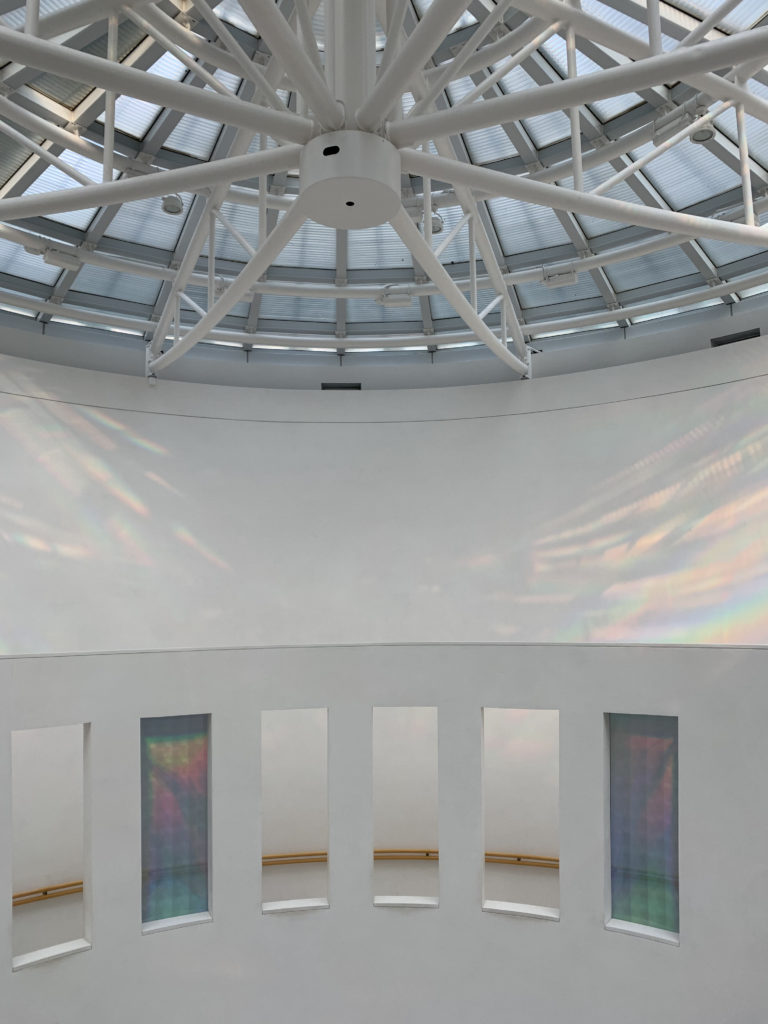
Inner view of Leeum Museum of Art with To Breathe (2021) by Kim Sooja. Photograph by Lou Anmella © Lou Anmella
Leeum Museum of Art
Le Leeum (contraction de Lee + (Mus)eum) figure dans le top 3 des plus belles collections privées d’art coréen. Les œuvres et objets d’art, traditionnel et contemporain, collectionnés par Lee Byung-chul, le fondateur de Samsung, sont des pièces d’exception, dont plus de 30 appartiennent au gotha des trésors nationaux. En 2004, trois architectes mondialement connus, Rem Koolhaas, Jean Nouvel et Mario Botta signent un musée à la hauteur des chefs d’œuvre de la collection. Par ce geste architectural et par des expositions temporaires résolument tournées vers le meilleur de la création coréenne et internationale, le Leeum Museum of Art est une escale incontournable pour les amateurs d’art actuel.
Une sélection d’expositions temporaires à voir en septembre 2024 au Leeum Museum of Art :
Anicka Yi, There Exists Another Evolution, But In This One (du 5 septembre au 29 décembre) : dans une exposition monographique, la première en Asie, conçue en partenariat avec l’UCCA de Pékin, le Leeum présente un panorama de l’univers créatif d’Anicka Yi. Célèbre pour son utilisation des matériaux organiques périssables, l’artiste coréano-américaine crée des installations qui croisent politique, recherches scientifiques et expérience esthétique. Une promesse de voyage en « sensations » !
2024 Art Spectrum Dream Screen (du 5 septembre au 29 décembre) : l’exposition part du constat que les artistes appartenant à la génération millénaire et post-millénaire ont développé un sens différent du monde physique par leur expérience des « écrans », de l’Internet, les jeux vidéo et des films. Les 26 artistes et équipes créatives exposés sont issus des cultures asiatiques, notamment de Corée, Thaïlande, Indonésie, Chine, Viêt Nam, Japon, Myanmar.
The Leeum (contraction of Lee + (Mus)eum) is one of the top 3 private collections of Korean art. The art works and objects collected by Samsung founder Lee Byung-chul are of exceptional quality. More than 30 of them are considered National treasures. In 2004, three world-renowned architects, Rem Koolhaas, Jean Nouvel and Mario Botta, designed an envelope worthy of the collection’s masterpieces. The outstanding building, the exquisite permanent collection of traditional Korean art, the temporary exhibitions resolutely focused on the best Korean and international contemporary creation: the Leeum Museum of Art is definitely a must-see for art lovers.
A selection of temporary exhibitions at Leeum Museum of Art in September 2024:
« Anicka Yi, There Exists Another Evolution, But In This One » (2024.09.05 ~ 2024.12.29): in a monographic exhibition, the first in Asia, conceived in partnership with Beijing’s UCCA, Leeum presents a panorama of Anicka Yi’s creative universe. Renowned for her use of perishable organic materials, the Korean-American artist creates installations that combine politics, scientific research and aesthetic experience. The promise of a “sensational” journey!
« 2024 Art Spectrum Dream Screen » (2024.09.05 ~ 2024.12.29): in an era where experiences through screens with internet, games, and movies have become commonplace, this exhibition explores the different sense of the physical world developed by artists belonging to the millennial and post-millennial generation. The 26 participating artists/teams in this exhibition are based in Asian cultures, including artists from Korea, Thailand, Indonesia, China, Vietnam, Japan and Myanmar.
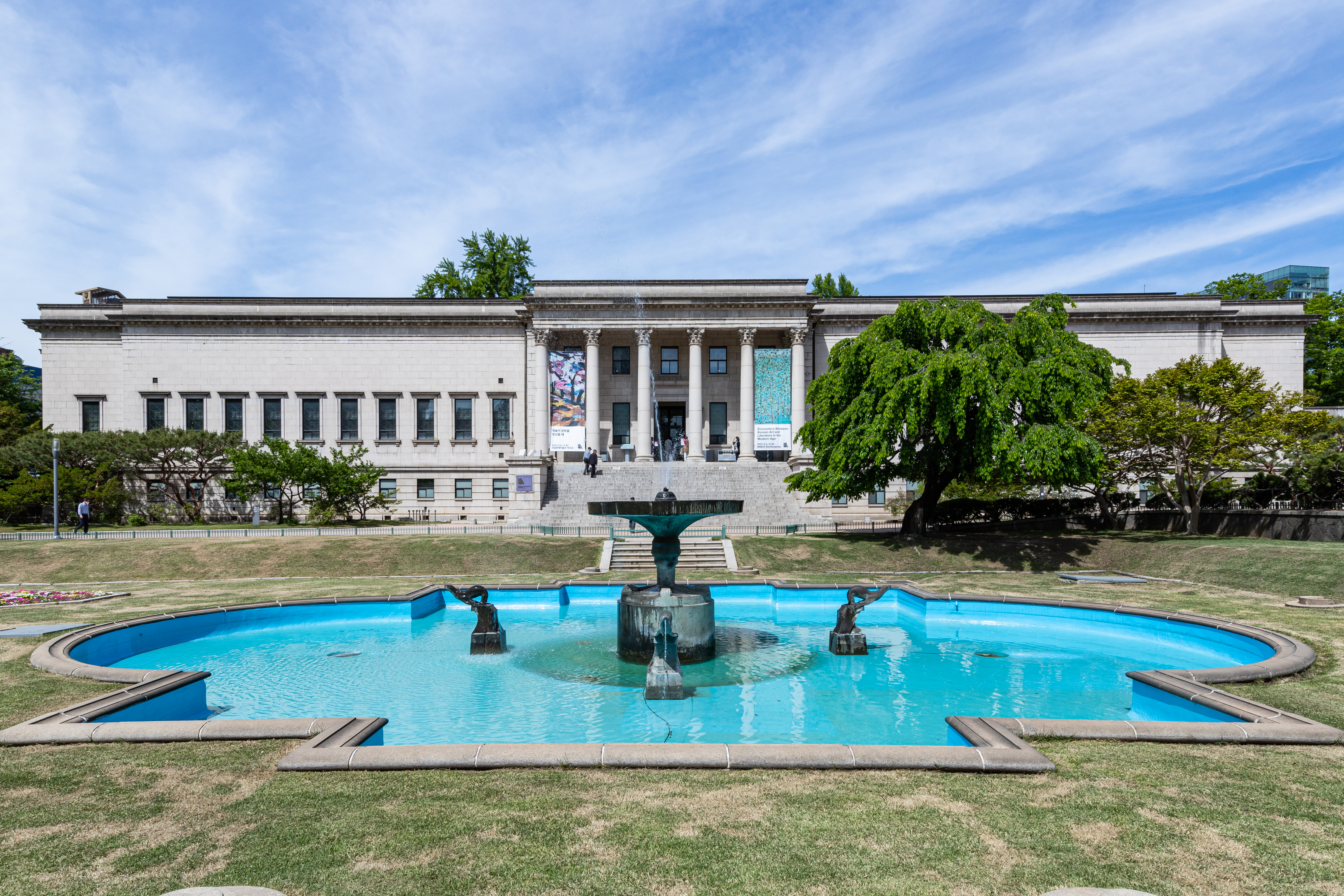
MMCA-Deoksugung. Photograph by Park Jung Hoon © Park Jung Hoon 
MMCA-Gwacheon, The More, The Better by Nam June Paik. Photograph by Woo Jongduk © MMCA
MMCA, National Museum of Modern and Contemporary Art
Le musée national d’art moderne et contemporain a été fondé en 1969 avec l’ambition de valoriser l’art coréen de 1910 à aujourd’hui. Il comprend 4 sites, à l’identité singulière, dont 3 à Séoul : MMCA-Séoul (2013), MMCA-Deoksugung (1998) et MMCA-Gwacheon (1986). Chacun des pôles du MMCA mérite une visite car, dans tous, les expositions sont généreuses en œuvres, ambitieuses par les sujets et à la pointe de la recherche en histoire de l’art. Sept espaces d’exposition, un jardin de sculptures niché au cœur de la montage et The More, The Better, une ziggurat de télévisions élevée jusqu’à 18,5m par Nam June Paik,rendent inoubliable le MMCA-Gwacheon. Les expositions du MMCA-Deoksugung explorent les richesses de l’art moderne coréen. Le palais Seokjojeon, premier édifice en pierre d’inspiration occidentale jamais construit en Corée au début du 20e siècle, lui sert d’écrin. Multiplex culturel tourné vers le futur, MMCA-Séoul s’attache à détecter et mettre en lumière tout ce qui crée l’innovation dans les arts visuels : gaming et art expérimental ont été récemment les fils conducteurs d’un programme d’expositions d’avant-garde.
Une sélection d’expositions temporaires à voir en septembre 2024 au MMCA :
Au MMCA-Gwacheon, Performative Home: Architecture for Alternative Living (jusqu’au 2 février 2025) : l’exposition présente 58 maisons conçues par 30 architectes ou groupes d’architectes coréens Ils s’interrogent sur l’avenir de la culture résidentielle en Corée au 21e siècle, alors que la société est en pleine mutation, tout comme les environnements climatiques et économiques.
Au MMCA-Séoul, Connecting Bodies: Asian Women Artists (du 3 septembre 2024 au 3 mars 2025) : Comment traiter de la corporalité en art ? Soixante femmes artistes, originaires de Chine, d’Inde, d’Indonésie, du Japon, de Corée, de Malaisie, des Philippines, de Singapour, de Taïwan et de Thaïlande répondent à cette problématique avec des créations qui vont des années 1960 jusqu’à aujourd’hui.
Au MMCA-Deoksogung, MMCA Collection: Social Life of Artworks (du 12 septembre au 13 octobre 2024) : l’exposition est une introduction à l’art moderne et contemporain coréen grâce à la sélection de peintures, sculptures et calligraphies appartenant à des organismes publics. Kim Eunho, Kim Insoong, Kim Whanki, Park Seobo, Lee Ungno, and Chung Changsup comptent parmi les quarante artistes représentés.
The National Museum of Modern and Contemporary Art was founded in 1969 with the ambition of showcasing Korean art from 1910 to the present day. It comprises 4 sites with singular identities, 3 of which are in Seoul: MMCA-Seoul (2013), MMCA-Deoksugung (1998) and MMCA-Gwacheon (1986). Each of the MMCA’s hubs is well worth a visit. Their exhibitions are always generous, tackle ambitious subjects and are based on cutting edge art-history research. Nestled in the heart of Seoul southern mountain range, MMCA-Gwacheon is really a special place. Its seven exhibition spaces, its vast sculpture garden and its massive 18.5m high television ziggurat The More, The Better by Nam June Paik, contribute to an unforgettable visit. Exhibitions at MMCA-Deoksugung explore the riches of modern Korean art. The Seokjojeon Palace, the first Western-inspired stone building ever constructed in Korea in the early 20th century, serves as a showcase. A cultural multiplex looking to the future, MMCA-Seoul is committed to detecting and highlighting everything that creates innovation in the visual arts: gaming and experimental art have recently been the common threads of a program of avant-garde exhibitions.
A selection of temporary exhibitions at MMCA in September 2024:
At MMCA-Gwacheon, « Performative Home: Architecture for Alternative Living » (2024-07-19 ~ 2025-02-02): the exhibition presents 58 houses designed by 30 Korean architects or groups of architects, who consider the future of residential culture in Korea in the 21st century. What alternative lifestyles can be imagined in a society where family and economic structures, lifestyles and climate are undergoing radical change?
At MMCA-Seoul, « Connecting Bodies: Asian Women Artists » (2024-09-03 ~ 2025-03-03): this international exhibition will be focusing on the work of 60 Asian female artists, originated from China, India, Indonesia, Japan, Korea, Malaysia, Philippines, Singapore, Taiwan and Thailand. This thematic and comparative exhibition will explore the way in which women artists have dealt with corporality, from the 60s to present days.
At MMCA-Deoksogung, « MMCA Collection: Social Life of Artworks » (2024-09-12 ~ 2024-10-13): the exhibition introduces modern and contemporary Korean art through a selection of paintings, sculptures and calligraphy belonging to public institutions. World renowned Kim Eunho, Kim Insoong, Kim Whanki, Park Seobo, Lee Ungno, and Chung Changsup are among the forty artists represented.
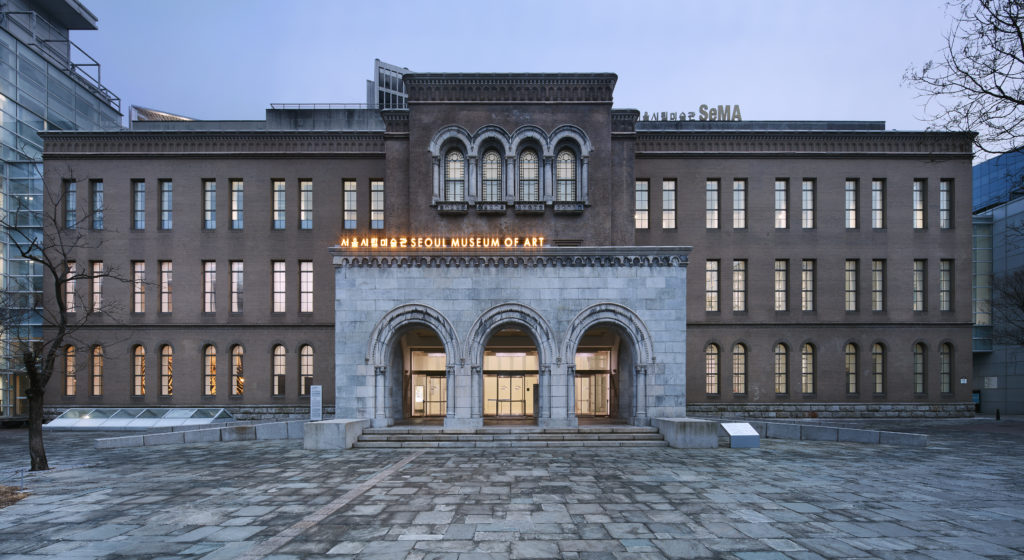
Seoul Museum of Art Seosomun Main Branch. Photo © Kim YongKwan 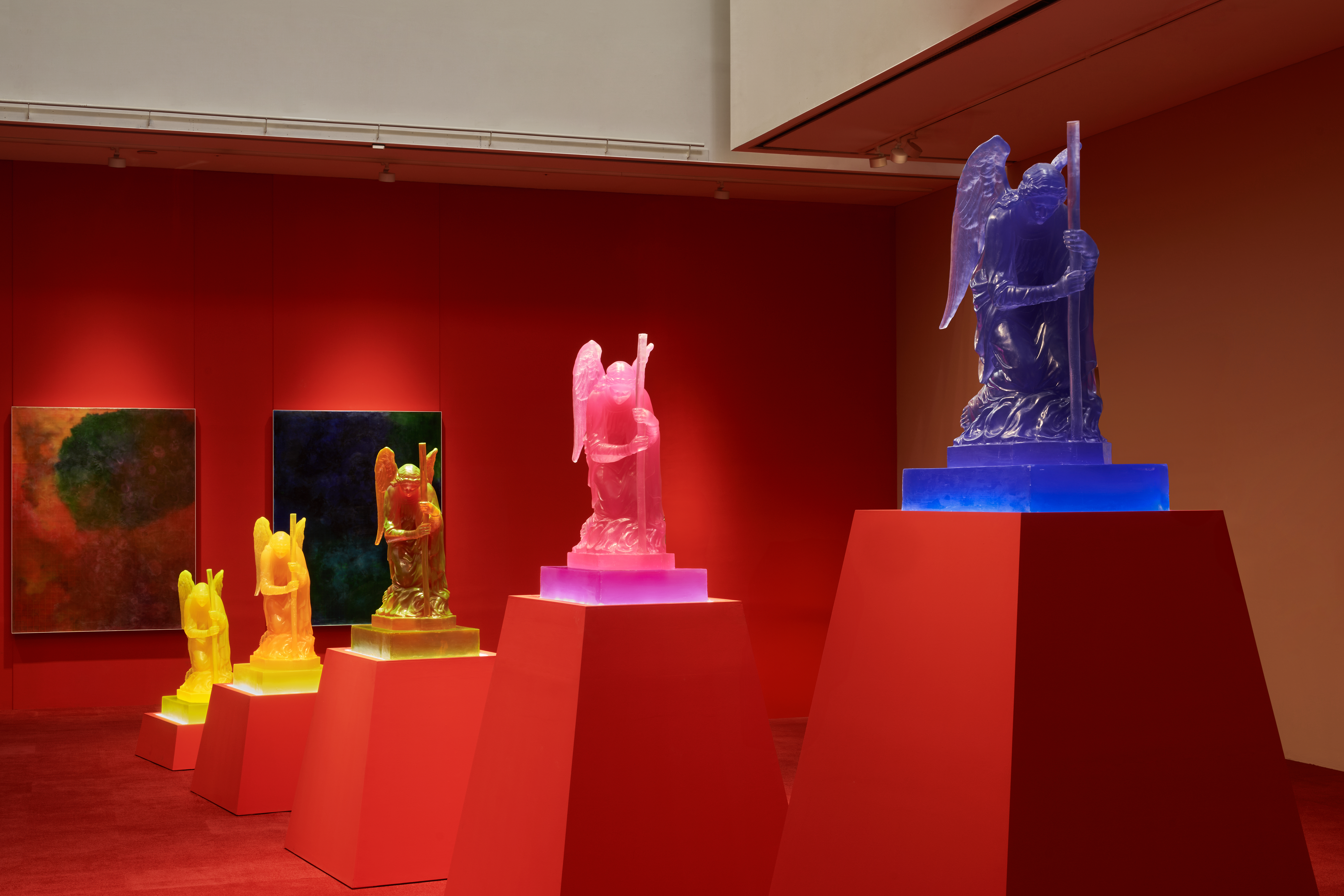
Installation view of Celestial Whisper, SeMA, Buk-Seoul Museum of Art, 2024. © Courtesy Seoul Museum of Art. Photo: sonongji
SeMA, Seoul Museum of Art
Le SeMA est un réseau municipal de huit musées, espaces d’archives et de création, qui ambitionne de « transporter l’art dans la vie quotidienne ». Le SeMA-Seosomun Main Branch, avec sa façade en brique, caractéristique de l’époque coloniale japonaise en est le vaisseau amiral, inauguré en 1988. Au sud, Nam-Seoul Museum of Art installé dans l’ancienne ambassade de Belgique, au nord, Buk-Seoul Museum of Art et son jardin de sculptures, à l’ouest, le SeMA Bunker abrité dans une mystérieuse construction des années 1970, contribuent à la diffusion de l’art contemporain coréen et international sur le vaste territoire de Séoul. Ce rayonnant ensemble muséal, bientôt complété par deux nouveaux établissements, est réputé pour une programmation éclectique, volontiers ouverte sur le monde et qui ne manque pas d’audace.
Une sélection d’expositions temporaires à voir en septembre 2024 au SeMA :
Actuellement, la collection municipale d’artistes coréens des 20e et 21e siècles se dévoile dans l’exposition SeMA-Omnibus, déployée sur 4 sites : Seosomun Main Branch, SeMA Art Archives, Buk-Seoul Museum of Art et Nam-Seoul Museum of Art. Enfin, Nam-Seoul Museum of Art montre de manière permanente des œuvres de Kwon Jin Kyu, sculpteur coréen majeur du 20e siècle
Au SeMA-Seosomun Main Branch, CHUN Kyung-ja Centennial « Turbulent Times: Women Life Art » (jusqu’au 17 novembre 2024) : l’exposition révèle comment les systèmes politiques et sociaux du 20e siècle en Corée ont influencé la vie et les œuvres de 23 artistes femmes. Une occasion unique de découvrir la participation de si nombreuses femmes à l’histoire de l’art coréen.
Au Buk-Seoul Museum of Art, Celestial Whisper, jusqu’au 5 mai 2025 : depuis 30 ans, Meekyoung Shin a créé un ensemble unique d’œuvres, utilisant le savon comme matériau principal. Dans cette exposition, Shin met en lumière les anges, intermédiaires entre Dieu et les humains.
SeMA is a municipal network of museums, archives and creative spaces. Its ambition is to “bring art into everyday life”. Its flagship in the center of Seoul is the SeMA-Seosomun, inaugurated in 1988, with its brick façade characteristic of the Japanese colonial era. In the south, the Nam-Seoul Museum of Art is housed in the early 20th century former Belgian embassy. In the North, you will find the Buk-Seoul Museum of Art and its sculpture garden. In the West, the SeMA Bunker, housed in a mysterious building from the 1970s. All contribute to the dissemination of contemporary Korean and international art throughout Seoul’s vast territory. This radiant museum network, soon to be completed by two brand new establishments, is renowned for its eclectic programming, which is open to the world and never lacks audacity.
A selection of temporary exhibitions at SeMA in September 2024:
Currently, the municipal collection of Korean artists from the 20th and 21st century is on show in the SeMA-Omnibus exhibition, spread over 4 sites: Seosomun Main Branch, Art Archives, Buk-Seoul Museum of Art and Nam-Seoul Museum of Art, while Nam-Seoul Museum of Art permanently displays works by Kwon Jin Kyu, a major Korean sculptor of the 20th century.
At SeMA-Seosomun Main Branch, « CHUN Kyung-ja Centennial “Turbulent Times: Women Life Art” » (~ 2024.11.17): the exhibition reveals how the political and social systems of 20th-century Korea influenced the lives and works of 23 women artists. A unique opportunity to discover the contribution of women to the history of Korean art.
At the Buk-Seoul Museum of Art, « Celestial Whisper » (~ 2025.05.05): over the past 30 years, Meekyoung Shin has created a unique body of work, using soap as her principal material. In this exhibition, Shin highlights angels as intermediaries between God and humans.
ACA project est une association française dédiée à la promotion de la connaissance de l’art contemporain asiatique, en particulier l’art contemporain chinois, coréen, japonais et d’Asie du sud-est. Grâce à notre réseau de bénévoles et de partenaires, nous publions régulièrement une newsletter, des actualités, des interviews, une base de données, et organisons des événements principalement en ligne et à Paris. Si vous aimez nos articles et nos actions, n’hésitez pas à nous soutenir par un don ou à nous écrire.
ACA project is a French association dedicated to the promotion of the knowledge about Asian contemporary art, in particular Chinese, Korea, Japanese and South-East Asian art. Thanks to our network of volunteers and partners, we publish a bimonthly newsletter, as well as news, interviews and database, and we organise or take part in events mostly online or in Paris, France. If you like our articles and our actions, feel free to support us by making a donation or writing to us.
